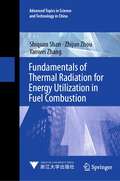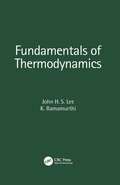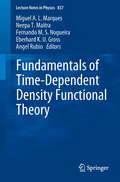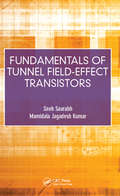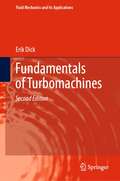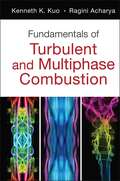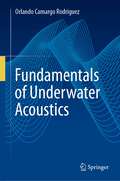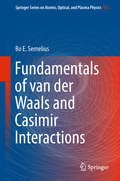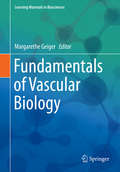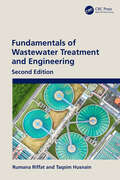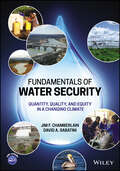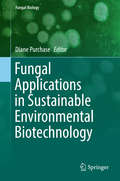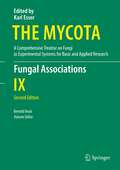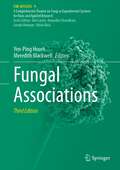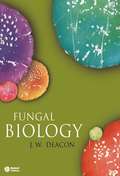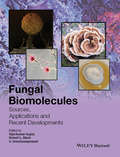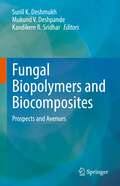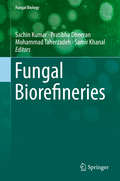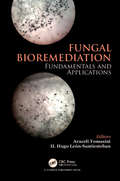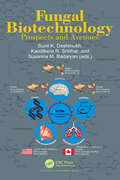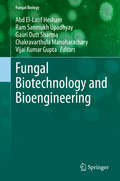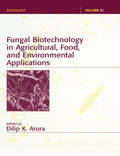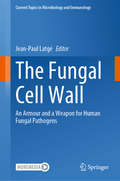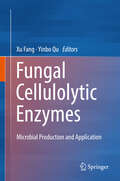- Table View
- List View
Fundamentals of Thermal Radiation for Energy Utilization in Fuel Combustion (Advanced Topics in Science and Technology in China #67)
by Shiquan Shan Zhijun Zhou Yanwei ZhangThis book is in the field of Engineering Thermophysics. It first introduces the authors’ academic thoughts of photo-thermal energy cascade conversion in the fuel combustion. Afterward, a series of thermal radiation theories and models have been developed based on the aim of radiative energy utilization, including spectral radiation available energy theory, gas radiation model under complex combustion conditions, and calculation model of radiation available energy transfer in combustion medium. Based on simulation and experimental results, the radiative energy characteristics of different fuel combustion are introduced. This book develops the radiation theory of the combustion process from a new perspective, integrating theories, models, and experimental results. This book can be used as a reference for scientists, engineers, and graduate students engaged in energy environment, combustion, and thermal radiation.
Fundamentals of Thermodynamics
by John H. Lee K. RamamurthiA concise treatment of the fundamentals of thermodynamics is presented in this book. In particular, emphasis is placed on discussions of the second law, a unique feature of thermodynamics, which states the limitations of converting thermal energy into mechanical energy. The entropy function that permits the loss in the potential of a real thermodynamic process to be assessed, the maximum possible work in a process, and irreversibility and equilibrium are deduced from the law through physical and intuitive considerations. They are applicable in mitigating waste heat and are useful for solving energy, power, propulsion and climate-related issues.The treatment is not restricted to properties and functions of ideal gases. The ideal gas assumption is invoked as a limiting case. Reversible paths between equilibrium states are obtained using reversible heat engines and reversible heat pumps between environment and systems to determine the entropy changes and the maximum work. The conditions of thermodynamic equilibrium comprising mechanical, thermal, chemical and phase equilibrium are addressed and the species formed at equilibrium in a chemical reaction at a given temperature and pressure are obtained. The molecular basis for the laws of thermodynamics, temperature, internal energy changes, entropy, reversibility and equilibrium are briefly discussed.The book serves as a reference for undergraduate and graduate students alongside thermodynamics textbooks.
Fundamentals of Time-Dependent Density Functional Theory
by Fernando M.S. Nogueira Miguel A.L. Marques Angel Rubio Neepa T. Maitra E.K.U. GrossThere have been many significant advances in time-dependent density functional theory over recent years, both in enlightening the fundamental theoretical basis of the theory, as well as in computational algorithms and applications. This book, as successor to the highly successful volume Time-Dependent Density Functional Theory (Lect. Notes Phys. 706, 2006) brings together for the first time all recent developments in a systematic and coherent way. First, a thorough pedagogical presentation of the fundamental theory is given, clarifying aspects of the original proofs and theorems, as well as presenting fresh developments that extend the theory into new realms--such as alternative proofs of the original Runge-Gross theorem, open quantum systems, and dispersion forces to name but a few. Next, all of the basic concepts are introduced sequentially and building in complexity, eventually reaching the level of open problems of interest. Contemporary applications of the theory are discussed, from real-time coupled-electron-ion dynamics, to excited-state dynamics and molecular transport. Last but not least, the authors introduce and review recent advances in computational implementation, including massively parallel architectures and graphical processing units. Special care has been taken in editing this volume as a multi-author textbook, following a coherent line of thought, and making all the relevant connections between chapters and concepts consistent throughout. As such it will prove to be the text of reference in this field, both for beginners as well as expert researchers and lecturers teaching advanced quantum mechanical methods to model complex physical systems, from molecules to nanostructures, from biocomplexes to surfaces, solids and liquids. From the reviews of LNP 706: "This is a well structured text, with a common set of notations and a single comprehensive and up-to-date list of references, rather than just a compilation of research articles. Because of its clear organization, the book can be used by novices (basic knowledge of ground-state DFT is assumed) and experienced users of TD-DFT, as well as developers in the field." (Anna I. Krylov, Journal of the American Chemical Society, Vol. 129 (21), 2007) "This book is a treasure of knowledge and I highly recommend it. Although it is a compilation of chapters written by many different leading researchers involved in development and application of TDDFT, the contributors have taken great care to make sure the book is pedagogically sound and the chapters complement each other [...]. It is highly accessible to any graduate student of chemistry or physics with a solid grounding in many-particle quantum mechanics, wishing to understand both the fundamental theory as well as the exponentially growing number of applications. [...] In any case, no matter what your background is, it is a must-read and an excellent reference to have on your shelf." Amazon.com, October 15, 2008, David Tempel (Cambridge, MA)
Fundamentals of Tunnel Field-Effect Transistors
by Mamidala Jagadesh Kumar Sneh SaurabhDuring the last decade, there has been a great deal of interest in TFETs. To the best authors’ knowledge, no book on TFETs currently exists. The proposed book provides readers with fundamental understanding of the TFETs. It explains the interesting characteristics of the TFETs, pointing to their strengths and weaknesses, and describes the novel techniques that can be employed to overcome these weaknesses and improve their characteristics. Different tradeoffs that can be made in designing TFETs have also been highlighted. Further, the book provides simulation example files of TFETs that could be run using a commercial device simulator.
Fundamentals of Turbomachines (Fluid Mechanics and Its Applications #130)
by Erik DickThis textbook explores the working principles of all kinds of turbomachines. The same theoretical framework is used to analyze the different machine types. The order in which the different kinds are treated is chosen by the possibility of gradually building up theoretical concepts. For each of the turbomachine kinds, a balance is sought between fundamental understanding and knowledge of practical aspects. Readers are invited through challenging exercises to consider how the theory applies to particular cases. This textbook appeals to senior undergraduate and graduate students in mechanical engineering and to professional engineers seeking to understand the operation of turbomachines. Readers will gain a fundamental understanding of turbomachines and will be able to make a reasoned choice of a turbomachine for a particular application.
Fundamentals of Turbulent and Multi-Phase Combustion
by Kenneth Kuan-yun Kuo Ragini AcharyaDetailed coverage of advanced combustion topics from the author of Principles of Combustion, Second EditionTurbulence, turbulent combustion, and multiphase reacting flows have become major research topics in recent decades due to their application across diverse fields, including energy, environment, propulsion, transportation, industrial safety, and nanotechnology. Most of the knowledge accumulated from this research has never been published in book form-until now. Fundamentals of Turbulent and Multiphase Combustion presents up-to-date, integrated coverage of the fundamentals of turbulence, combustion, and multiphase phenomena along with useful experimental techniques, including non-intrusive, laser-based measurement techniques, providing a firm background in both contemporary and classical approaches. Beginning with two full chapters on laminar premixed and non-premixed flames, this book takes a multiphase approach, beginning with more common topics and moving on to higher-level applications.In addition, Fundamentals of Turbulent and Multiphase Combustion: Addresses seven basic topical areas in combustion and multiphase flows, including laminar premixed and non-premixed flames, theory of turbulence, turbulent premixed and non-premixed flames, and multiphase flows Covers spray atomization and combustion, solid-propellant combustion, homogeneous propellants, nitramines, reacting boundary-layer flows, single energetic particle combustion, and granular bed combustion Provides experimental setups and results whenever appropriateSupported with a large number of examples and problems as well as a solutions manual, Fundamentals of Turbulent and Multiphase Combustion is an important resource for professional engineers and researchers as well as graduate students in mechanical, chemical, and aerospace engineering.
Fundamentals of Underwater Acoustics
by Orlando Camargo RodríguezThis textbook on Underwater Acoustics has a structure that is more organic than logical. It thereby unifies diverse areas of research, including topics of signal processing, the sonar equation, sources and receivers, scattering and reverberation, wave propagation, propagation models, and inverse problems. It also provides code fragments written in Python which complement the discussion. This is a book written for both beginners and specialists, as well as for biologists, oceanographers, computer engineers, physicists, and mathematicians, and for civilian and naval personnel who are looking for a introductory overview of the topic.
Fundamentals of van der Waals and Casimir Interactions (Springer Series on Atomic, Optical, and Plasma Physics #102)
by Bo E. SerneliusThis book presents a self-contained derivation of van der Waals and Casimir type dispersion forces, covering the interactions between two atoms but also between microscopic, mesoscopic, and macroscopic objects of various shapes and materials. It also presents detailed and general prescriptions for finding the normal modes and the interactions in layered systems of planar, spherical and cylindrical types, with two-dimensional sheets, such as graphene incorporated in the formalism. A detailed derivation of the van der Waals force and Casimir-Polder force between two polarizable atoms serves as the starting point for the discussion of forces: Dispersion forces, of van der Waals and Casimir type, act on bodies of all size, from atoms up to macroscopic objects. The smaller the object the more these forces dominate and as a result they play a key role in modern nanotechnology through effects such as stiction. They show up in almost all fields of science, including physics, chemistry, biology, medicine, and even cosmology. Written by a condensed matter physicist in the language of condensed matter physics, the book shows readers how to obtain the electromagnetic normal modes, which for metallic systems, is especially useful in the field of plasmonics.
Fundamentals of Vascular Biology (Learning Materials in Biosciences)
by Margarethe GeigerThis well-structured textbook offers essential knowledge on the vascular system. The reader will learn the properties, basic cellular mechanisms and development of the different parts of the vascular system (including the heart), gain knowledge on vascular and related diseases, and will be made familiar with common and most current methods and techniques applied to analyze the vascular system in patients, in animal models, and ex vivo. This book is based on a PhD Course for students from various bioscientific backgrounds given at the Medical University of Vienna, and it will be a valuable resource for Master´s Students in vascular biology and biomedicine in general and a helpful tool for young researchers world-wide wishing to gain or refresh their knowledge in this field.
Fundamentals of Wastewater Treatment and Engineering
by Rumana Riffat Taqsim HusnainThe 2nd edition of Fundamentals of Wastewater Treatment and Design introduces readers to the fundamental concepts of wastewater treatment, followed by engineering design of unit processes for sustainable treatment of municipal wastewater and resource recovery. It has been completely updated with new chapters to reflect current advances in design, resource recovery practices and research. Another highlight is the addition of the last chapter, which provides a culminating design experience of both urban and rural wastewater treatment systems. Filling the need for a textbook focused on wastewater, it covers history, current practices, emerging concerns, future directions and pertinent regulations that have shaped the objectives of this important area of engineering. Basic principles of reaction kinetics, reactor design and environmental microbiology are introduced along with natural purification processes. It also details the design of unit processes for primary, secondary and advanced treatment, as well as solids processing and removal. Recovery of water, energy and nutrients are explained with the help of process concepts and design applications. This textbook is designed for undergraduate and graduate students who have some knowledge of environmental chemistry and fluid mechanics. Professionals in the wastewater industry will also find this a handy reference.
Fundamentals of Water Security: Quantity, Quality, and Equity in a Changing Climate
by Jim F. Chamberlain David A. SabatiniFUNDAMENTALS OF WATER SECURITY Understand How to Manage Water Resources to Equitably Meet Both Human and Ecological Needs Burgeoning populations and the ever-higher standards of living for those in emerging countries increase the demand on our water resources. What is not increasing, however, is the supply of water and the total amount of water in earth’s biosphere—water that is integral to all standards of living. Fundamentals of Water Security provides a foundation for understanding and managing the quantity-quality-equity nexus of water security in a changing climate. In a broad sense, this volume explores solutions to water security challenges around the world. It is richly illustrated and pedagogically packed with up-to-date information. The text contains chapter learning objectives, foundation sections reviewing quantitative skills, case studies, and vignettes of people who have made important contributions to water security. To further aid comprehension, end-of-chapter problems are included—both qualitative and quantitative, with solutions available to instructors. Finally, extensive references feature books, journal articles, and government and NGO reports. Sample topics discussed include: How the study of water resources has evolved from a focus on physical availability to include social factors and governance How water security affects multiple disciplines across environmental science and engineering, hydrology, geography, water resources, atmospheric science, chemistry, biology, health science, and social and political science fields How to achieve a sufficient quantity and quality of water to equitably meet both immediate and long-term human and ecological needs Analysis of water security in an integrated manner by underscoring the complex interactions between water quantity, water quality, and society Students taking courses on hydrology, water security, and/or water resource management, along with scientists working in fields where water security is a factor will be able to use Fundamentals of Water Security as a comprehensive textbook to understand and achieve water security.
Fungal Applications in Sustainable Environmental Biotechnology
by Diane PurchaseFungi are distinct eukaryotic organisms renowned for their remarkable biodiversity and extensive range of habitats. Many fungal species have long been exploited for food and medicines. This volume considers other important applications of fungal biotechnology especially in an environmental context, showcasing the essential contributions of these amazingly versatile organisms. It explores how fungi offer sustainable solutions to tackle various environmental concerns. Written by eminent experts in their fields, this work presents a broad array of current advances and future prospects in fungal environmental biotechnology and discusses their limitations and potential. The book is organized in five parts, each addressing a theme of the UN Sustainable Development Goals (SDG): strengthen food security (Zero Hunger), wastewater treatment (Clean Water & Sanitation), pollution reduction (Life on Land), biofuel production (Affordable & Clean Energy) and biosynthesis of novel biomolecules (Responsible Consumption & Production).
Fungal Associations
by Bertold HockThis new edition of Fungal Associations focuses on mycorrhizas, lichens and fungal-bacterial symbioses. It has been completely revised, updated and expanded. Renowned experts present thorough reviews and discuss the most recent findings on molecular interactions between fungi and plants or bacteria that lead to morphological alterations and novel properties in the symbionts. New insights into the beneficial impact of fungal associations on ecosystem health are provided and documented with striking examples.
Fungal Associations (The Mycota #9)
by Yen-Ping Hsueh Meredith BlackwellFungi are associated with a wide variety of other organisms. Ecologist Peter Price has said, “mutualism facilitates adaptive radiation,” and many biologists attribute Earth’s great fungal diversity to such associations. The 3rd edition of The Mycota, Vol. 9: Fungal Associations, has been revised to provide entirely new coverage of fungi and associated organisms in fourteen informative discussions that take advantage of today’s large public databases and modern molecular and data analysis methods. The editors have a keen interest in fungal associations in their own research, and their perspectives from different generations have resulted in an interesting treatment of the subject. Fungal Associations includes updates of classic topics, but also introduces less frequently discussed associations and broader reflections on the nature of fungi and their associates. The volume begins with a look at more than a billion years of fungal evolution and associations through the lens of immunology. Can fungi involved in obligate symbioses be cultivated apart from the host? Genomes help to answer the question. The ultimate intimacy between fungi and certain unrelated organisms has resulted in DNA exchange that can be traced in extant genomes. Fungi and bacteria use volatile compounds to lure participants into interactions. Some viruses modify the phenotype of their fungal hosts and affect host fitness. Details of interactions between classical examples of fungus—plant symbioses (lichens, several types of mycorrhizae, and toxic endophytes) benefit from advanced microscopic and molecular techniques.Discussions of fungi associated with insects (entomopathogens, a Drosophila model to study entomopathogens), nematode-trapping fungi and their prey, and a group of termite-associated fungi that produce secondary metabolites with potential uses as pharmaceuticals, complete the volume. Fungal Associations is a well-illustrated, thought-provoking resource for specialists and generalists, including researchers, lecturers, and students interested in ecology, evolution, microbiology, and mycology. The volume would be an excellent text for a seminar course for advanced undergraduate or graduate students.
Fungal Biology
by J. W. DeaconVisit the accompanying website from the author at www.blackwellpublishing.com/deacon. Fungal Biology is the fully updated new edition of this undergraduate text, covering all major areas of fungal biology and providing insights into many topical areas. Provides insights into many topical areas such as fungal ultrastructure and the mechanisms of fungal growth, important fungal metabolites and the molecular techniques used to study fungal populations. Focuses on the interactions of fungi that form the basis for developing biological control agents, with several commercial examples of the control of insect pests and plant diseases. Emphasises the functional biology of fungi, with examples from recent research. Includes a clear illustrative account of the features and significance of the main fungal groups.
Fungal Biology in the Origin and Emergence of Life
by David MooreThe rhythm of life on Earth includes several strong themes contributed by Kingdom Fungi. So why are fungi ignored when theorists ponder the origin of life? Casting aside common theories that life originated in an oceanic primeval soup, in a deep, hot place, or even a warm little pond, this is a mycological perspective on the emergence of life on Earth. The author traces the crucial role played by the first biofilms - products of aerosols, storms, volcanic plumes and rainout from a turbulent atmosphere - which formed in volcanic caves 4 billion years ago. Moore describes how these biofilms contributed to the formation of the first prokaryotic cells, and later, unicellular stem eukaryotes, highlighting the role of the fungal grade of organisation in the evolution of higher organisms. Based on the latest research, this is a unique account of the origin of life and its evolutionary diversity to the present day.
Fungal Biomolecules: Sources, Applications and Recent Developments
by Vijai Kumar Gupta Prof. Robert L. Mach Prof. S. SreenivasaprasadFungi have an integral role to play in the development of the biotechnology and biomedical sectors. The fields of chemical engineering, Agri-food,Biochemical, pharmaceuticals, diagnostics and medical device development allemploy fungal products, with fungal biomolecules currently used in a wide range of applications, ranging from drug development to food technology and agricultural biotechnology. Understanding the biology of different fungi in diverse ecosystems, as well as their biotropic interactions with other microorganisms, animals and plants, is essential to underpin effective and innovative technological developments.Fungal Biomolecules is a keystone reference, integrating branches of fungal product research into a comprehensive volume of interdisciplinary research. As such, it:reflects state-of-the-art research and current emerging issues in fungal biology and biotechnology reviews the methods and experimental work used to investigate different aspects of fungal biomolecules provides examples of the diverse applications of fungal biomolecules in the areas of food, health and the environmentis edited by an experienced team, with contributions from international specialists This book is an invaluable resource for industry-based researchers, academic institutions and professionalsworking in the area of fungal biology and associated biomolecules for their applications in food technology, microbial and biochemical process, biotechnology, natural products, drug development and agriculture.
Fungal Biopolymers and Biocomposites: Prospects and Avenues
by Sunil K. Deshmukh Mukund V. Deshpande Kandikere R. SridharThe book covers an overview of fungal polymers, fungal mycelial biomass, and their applications besides providing a detailed account of various opportunities. This book also includes information on developments in mycotechnology related to fashion, furnishing, construction, packaging, mycelial-based bricks, construction binder, cementing materials, and so on. Other aspects include the value of chitin, chitosan, hydrophobins, lignocellulosic composites, oil recovery, biosurfactants and bioemulsifiers, nanofibers from pullulan, exopolymeric substances, bioresins, and biocomposites. Additional topics covered in the book include self-healing fungal concrete (which could help to build repairs) and recipe to inhibit fruit body formation, for living fungal biomaterial manufacture. There is no comprehensive book other than – some reviews, which addressed very brief historical developments and preliminary aspects of fungal biopolymers. Written by experts in their field from countries like Australia, India, USA, Germany, Turkey, Philippines, Oman, Belgium, Italy, Egypt, Brazil, and the United Kingdom, the chapters discuss at length applications of filamentous fungi in sustainable industrial pursuits and industrial developments with environmental safety. This book will be useful for students, teachers, researchers, and scientists in botany, microbiology, life sciences, biotechnology, agriculture and, industries that extensively use fungi for the production of value-added products.
Fungal Biorefineries (Fungal Biology)
by Sachin Kumar Pratibha Dheeran Mohammad Taherzadeh Samir KhanalThis book covers the applications of fungi used in biorefinery technology. As a great many different varieties of fungal species are available, the text focuses on the various applications of fungi for production of useful products including organic acids (lactic, citric, fumaric); hydrolytic enzymes (amylase, cellulases, xylanases, ligninases, lipases, pectinases, proteases); advanced biofuels (ethanol, single cell oils); polyols (xylitol); single cell protein (animal feed); secondary metabolites; and much more.
Fungal Bioremediation: Fundamentals and Applications
by Araceli Tomasini Campocosio Hector Hugo SantiestebanThis book highlights the role fungi play in bioremediation, as well as the mechanisms and enzymes involved in this process. It covers the application of bioremediation with fungi in polluted sites and gives a wide overview of the main applications of remediation, such as degradation of xenobiotics, gaseous pollutants, and metal reduction. The book explains the degradation of emergent pollutants and radioactive compounds by fungi, which is relevant to the current pollution problems that have been studied over the last few decades. The book also describes the most advanced techniques and tools that are currently used in this field of study.
Fungal Biotechnology: Prospects and Avenues (Progress in Mycological Research)
by Sunil K. DeshmukhTraditional studies in mycology mainly deal with damage caused by fungi, for instance, diseases of plants, animal ailments, air-borne pathogens, decomposition of wood and production of mycotoxins in food. Applied mycology focuses on the fermentation of foods (flours, bakery products, cheese and others) and production of fermented products (wine, beer and spirit). Further value-added approaches show the significance of fungi in the production of bioactive metabolites and pharmaceuticals used in the treatment of human diseases, including cancer, and plant diseases (e.g. pest control). Due to a dependence on fossil resources, production of bio-renewable merchandise gained importance and fungi serve as potential biological agents in sustaining global economy. Recent developments in mycology revealed their significance in the fields of advanced research, in particular building materials, packaging resources, electronic devises and leather-like goods. In addition, fungi possess several qualities to degrade non-biodegradable compounds in the ecosystem and assist in sustainable waste bioremediation. This book covers the current biotechnological advances and bio-prospect potential of fungi. Fungal biopolymers possess various applications, including prebiotics, therapeutics, immunoceuticals, drug-discovery and drug-delivery. Fungal bioactive metabolites have several implications beyond antibiotics, such as volatiles, biofuels, nematicides and pigments. They also serve as prospective tools in the production of nanoparticles of medicinal, nutritional and industrial significance. In view of environmental protection, fungal activity and products aid in bioremediation via degradation of xenobiotics and solid wastes. Fungi can produce agriculturally compatible metabolites to enhance plant production. Knowledge on fungal genomics facilitates the gene manipulation towards biotechnological applications (disease diagnosis, pathogen detection, gene expression and mutualistic interactions). This book addresses the application of fungi in different areas and serves as a potential knowledge bank for graduates, post-graduates and researchers contemplating fungal applications.
Fungal Biotechnology and Bioengineering (Fungal Biology)
by Abd El-Latif Hesham Ram Sanmukh Upadhyay Gauri Dutt Sharma Chakravarthula Manoharachary Vijai Kumar GuptaFungi are eukaryotic microorganisms that include both unicellular and multicellular species. They have a worldwide distribution and a wide range of applications in diverse sectors, from environmental, food and medicine to biotechnological innovations. Fungal biochemical genetics involves the study of the relationships between genome, proteome and metabolome, and the underlying molecular processes in both native and bioengineered fungi. This book provides a valuable resource on the challenges and potential of fungal biotechnology and related bioengineering and functional diversity for various industrial applications in the food, environmental, bioenergy and biorefining, and the biopharma sectors. In comparison to previous and related publications in the area of applied myco-biotech-engineering, this book bridges a knowledge gap in the areas related to prospects and investment as well as intellectual and technical issues. This book also provides information on recent commercial and economic interests in the area by juxtaposing the developments achieved in recent worldwide research and its many challenges.
Fungal Biotechnology in Agricultural, Food, and Environmental Applications (Mycology Ser. #Vol. 21)
by Dilip K. AroraContributions from 80 world-renowned authorities representing a broad international background lend Fungal Biotechnology in Agricultural, Food, and Environmental Applicationsfirst-class information on the biotechnological potential of entomopathogenic fungi and ergot alkaloids, applications of Trichoderma in disease control, and the d
The Fungal Cell Wall: An Armour and a Weapon for Human Fungal Pathogens (Current Topics in Microbiology and Immunology #425)
by Jean-Paul LatgéThis book illustrates, that the fungal cell wall is critical for the biology and ecology of all fungi and especially for human fungal pathogens. Readers will learn, that the composition of the fungal cell wall is a unique structure, which cannot be found in the human host. Consequently, the chapters outline, how the immune systems of both animals and humans have evolved to recognize conserved and unique elements of the fungal cell wall. As an application example, the authors also show, that the three-dimensional structures of the cell wall are excellent targets for the development of antifungal agents and chemotherapeutic strategies. With the combination of biological findings and medical outlooks, this volume is a fascinating read for scientists, clinicians and biomedical students.
Fungal Cellulolytic Enzymes: Microbial Production And Application
by Yinbo Qu Xu FangThe book provides an overview of the current knowledge on cellulolytic enzymes and their applications. It summarizes the mechanisms of synthesis and hydrolysis of cellulolytic enzymes, industrial fungal strains, genetic engineering of fungal strains and application of cellulolytic enzymes. This book will be a useful reference for researchers and bioengineering experts engaged in lignocelluloses biodegradation, biomass utilization, enzyme production and fungal molecular biology.
